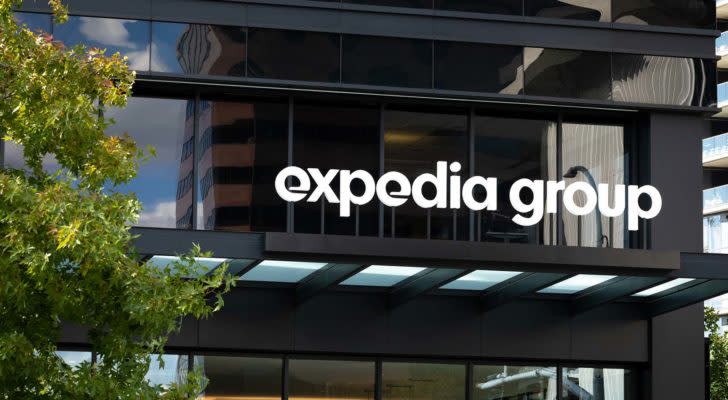7 Re-Opening Stocks to Buy If Omicron Proves Mild
First making headlines just after Thanksgiving, the omicron coronavirus variant threw markets for a loop late last month. Re-opening stocks in particular saw sharp declines, which were not helped by hawkish remarks from U.S. Federal Reserve Chairman Jerome Powell.
The jury’s still out on whether possible Fed policy changes will sink stocks further. But as more information comes out, optimism may be warranted. Why? This latest variant may not derail the pandemic recovery. Although spreading, and appearing more resistant to Covid-19 vaccines, some studies have shown that it causes less severe illness than prior variants.
Coupled with a lack of high concern for this variant among the public, the chances of renewed lockdowns and “social distancing” orders, at least in the United States, may be slim. This points to companies in industries hit hard by the initial outbreak continuing to recover. In turn, meeting (or beating) their respective earnings projections for 2022.
InvestorPlace - Stock Market News, Stock Advice & Trading Tips
So, among re-opening stocks, which ones look like buying opportunities after last month’s omicron meltdown? These seven could bounce back if initial fears about this latest variant prove to be overblown:
Expedia (NASDAQ:EXPE)
Southwest Airlines (NYSE:LUV)
Macerich (NYSE:MAC)
Penn National Gaming (NASDAQ:PENN)
Six Flags Entertainment (NYSE:SIX)
Wyndham Hotels & Resorts (NYSE:WH)
Xponential Fitness (NYSE:XPOF)
Re-Opening Stocks to Buy: Expedia (EXPE)

Source: VDB Photos / Shutterstock.com
It made a sharp recovery in late 2020 and early 2021. However, for most of this year, shares in travel booking company Expedia have traded sideways. Part of this may have to do with the cycling out of recovery names. This came after these once-hard hit names started to move up to prices well above pre-pandemic levels.
Yet a lot of it may have to do with Covid-19 variant fears, first delta and now omicron. New variants have heightened concern that the travel economy will not complete its recovery by 2022. That’s something many expected when the vaccine rollout kicked off a year ago.
That said, these fears may mean an opportunity for investors who “missed out” on the initial EXPE stock rebound. Why? So far, variants have not gotten in the way of the travel company’s recovery. As seen in its latest quarterly results, it’s delivering revenue and earnings numbers ahead of analyst projections. If omicron plays out in a similar manner as delta, or end up causing fewer disruptions than delta, the travel recovery could carry on over the next twelve months.
If Expedia continues to benefit from pent-up demand, it could deliver earnings per share (EPS) for 2022 that comes in at the top end of estimates ($10.09). In short, that may mean shares are trading at a forward price-to-earnings (P/E) ratio of 22.6x right now. Well below where its valuation was in prior years, the stock could deliver solid returns next year on multiple expansion.
Southwest Airlines (LUV)

Source: Carlos E. Santa Maria / Shutterstock.com
Airlines make up a large portion of the re-opening stocks. But that doesn’t mean all airlines are great buys. For example, legacy airlines, like American (NASDAQ:AAL), have disadvantages like high operating costs and high debt/long-term liabilities that make them unappealing investments, even if Covid enters the rearview mirror.
Fortunately, that’s not the case with Southwest Airlines. A low-cost carrier, it has an edge over its “old school” competitors. Not only that, as my InvestorPlace colleague Ian Bezek discussed last month, this airline has recovered faster. This is due mainly to its greater focus on leisure travel than business travel. Plus, there’s the fact that it has little exposure to international travel still affected by restrictions (i.e. Europe, Asia).
Nevertheless, these advantages meant little to investors. Like they’ve done to AAL stock, they have also bid down LUV stock. Bad news, of course, for those who bought it earlier this year. During the spring, before the delta variant, it traded for as much as $64.75 per share.
However, investors taking a look at it for the first time today may find it worth it to enter a position at current prices (around $39 per share). If omicron ends up having little impact on travel, the company could return to profitability next year. This could compel investors to send it back to above $60 per share.
Re-Opening Stocks to Buy: Macerich (MAC)

Source: mTaira / Shutterstock.com
After talking about two travel stocks, let’s look at another type of re-opening play: retail REITs. Macerich, America’s third-largest mall operator, was hit hard by the first coronavirus outbreak. In January 2020, it was trading for around $25 per share. By April 2020, it was trading for as low as $4.81 per share.
Since then, MAC stock has made a choppy recovery. For a brief moment last January, it became a meme stock. It zoomed back above $25 per share, before falling into the low-teens per share. Early last month, it tried again to get back to the $25 per share mark, but omicron has knocked it back once again.
New variants dampen its appeal as a recovery play. The rise of e-commerce puts additional pressure on brick-and-mortar retail. With all these uncertainties, why buy this mall REIT? Mainly, because it’s an owner of what are known as “Class A” or high-quality malls. It’s not in the same situation as owners of lower-quality, declining malls. Think Pennsylvania Real Estate Investment Trust (NYSE:PEI), or worse, Washington Prime Group (OTCMKTS:WPGGQ).
At the same time, despite its portfolio quality, Macerich trades at a lower price/funds from operations (P/FFO) ratio. This is a financial metric commonly used to value REITs. While it trades at a forward P/FFO ratio of 8.7x, its main class A rival, Simon Property Group (NYSE:SPG) trades at a P/FFO ratio of around 13x. A value play and a recovery play, consider it a buy if you think retail will show resilience in the face of omicron.
Penn National Gaming (PENN)

Source: Casimiro PT / Shutterstock.com
In hindsight, it’s clear things got out of hand with PENN stock earlier this year. Shares were already on a tear going into 2021. Excitement over the debut of its Barstool Sportsbook platform led investors to price the regional casino owner more like DraftKings (NASDAQ:DKNG) rather than closer peers like Boyd Gaming (NYSE:BYD).
Its connections to Barstool founder Dave Portnoy, who as you remember became a day trading superstar when lockdowns shut down sports in 2020, also played a big role in the hype around it. But since the end of the meme stock wave. Penn National has crash landed back to earth. Some of its more recent declines can be chalked to Portnoy becoming more of a liability than asset. You may recall last month he made headlines, this time due to a personal scandal.
Most of its decline, however, may have to do with Penn’s fundamentals. Barstool sports, despite the perception it would dominate sports betting, has so far seen only moderate success in its initial markets, such as Pennsylvania. Earnings for the company during the September quarter came in well below estimates as well.
So, with it falling out of favor, and down 67% from its highs, why buy now? Knocked down some more by omicron fears, it’s now at a more reasonable valuation (forward P/E of 18x). If this latest virus variant fails to impact its regional casinos, and if Barstool continues to grow, despite becoming an also-ran in terms of market share, even a partial recovery could mean big returns for investors buying today at around $46.54 per share.
Re-Opening Stocks to Buy: Six Flags Entertainment (SIX)

Source: Martina Badini/Shutterstock.com
Basically back to its pre-pandemic prices, you may wonder where the upside is with SIX stock. Especially as, given its current P/E multiple of 28.2x (based on 2021 earnings projections), it’s a stretch to call the theme park operator’s shares “undervalued.”
Ye,t with omicron fears pushing it slightly lower on the omicron news, you may want to consider buying it after its recent dip. Why? Whether or not this latest variant affects park attendance, it may have more room to run from here. At least, that’s the takeaway from a research report issued by Macquarie Research, after it reported Q3 earnings in late October.
Per Macquarie, the Delta variant had some impact on Six Flags park attendance during the summer. Even so, its quarterly revenue and adjusted EBITDA numbers ($638 million, and $279 million, respectively) came in well ahead of consensus ($588 million and $255 million, respectively).
If the same thing ends up playing out in the quarters ahead, Six Flags could continue to top estimates. In turn, delivering earnings next year ahead of current consensus ($2.21 per share). With this, it may be able to hit Macquarie’s price target of $55 per share. One of the top re-opening stocks, consider it a buy at today’s prices (around $39.90 per share).
Wyndham Hotels & Resorts (WH)

Source: Mihai_Andritoiu / Shutterstock.com
Like shares in other hotel franchisers, Wyndham Hotels has not only gotten back to pre-pandemic price levels, it’s gone past them. Even after its own omicron dip, at around $80 per share, it trades for more than one-third above the $60 it traded for before the virus.
Given that this re-opening stock has already delivered stunning returns during the recovery, why buy this? It may be up 46% in the past year, and more than five-fold since its Covid-era lows. Still, it may have room to deliver solid (albeit more modest) returns in 2022. That is, as long as this latest variant proves to be mild.
How? The hospitality company, which owns budget-focused brands like Super 8 and Days Inn, showed resilience during the worst of 2020’s lockdowns. This resiliency has carried on during the Delta variant, on full display in its most recent financial results, and in its upping of guidance for 2021.
That’s not all. Trading for 23.2x projected earnings for 2022, it’s more reasonably priced than its peers. For example, a similar peer, Choice Hotels International (NYSE:CHH), trades for 29.2x projected 2022 earnings. Another rival, Marriott International (NASDAQ:MAR) trades a similar (28.1x) forward earnings multiple. Before it heads back to its past high ($89.48 per share) and beyond, consider making this travel stock a buy.
Re-Opening Stocks to Buy: Xponential Fitness (XPOF)

Source: Goran Bogicevic / Shutterstock.com
Going public last July, boutique gym franchiser Xponential Fitness has not received a whole lot of coverage so far. However, shares in the company, which licenses fitness brands like Club Pilates and Cycle Bar, have performed well since its IPO, when it debuted for trading at $12 per share.
The stock has also held up despite the worries over this latest variant. Trading for around $21.80 per share before the omicron news, it dipped back below $20 per share, before bouncing back to above $24 within a few days. Pulling back again, now may be the time to buy it.
Growing faster than other publicly-traded fitness companies, like Planet Fitness (NYSE:PLNT), and set to get out of the red starting next year, continued growth and better results could pave a clear path to higher prices. With stronger results, and possibly more awareness of it among the investing public, XPOF stock may follow up its strong 2021 performance, with another round of tremendous gains in 2022.
Trading for 26.6x estimated earnings for 2022, it may also be one of the more reasonably-priced ways to play the “return to gym” trend; a trend that will see little reversal, if omicron in the end proves to have minimal impact on the overall “return to normal.”
On the date of publication, Thomas Niel did not have (either directly or indirectly) any positions in the securities mentioned in this article. The opinions expressed in this article are those of the writer, subject to the InvestorPlace.com Publishing Guidelines.
Thomas Niel, contributor for InvestorPlace.com, has been writing single-stock analysis for web-based publications since 2016.
More From InvestorPlace
The post 7 Re-Opening Stocks to Buy If Omicron Proves Mild appeared first on InvestorPlace.

 雅虎香港財經
雅虎香港財經 